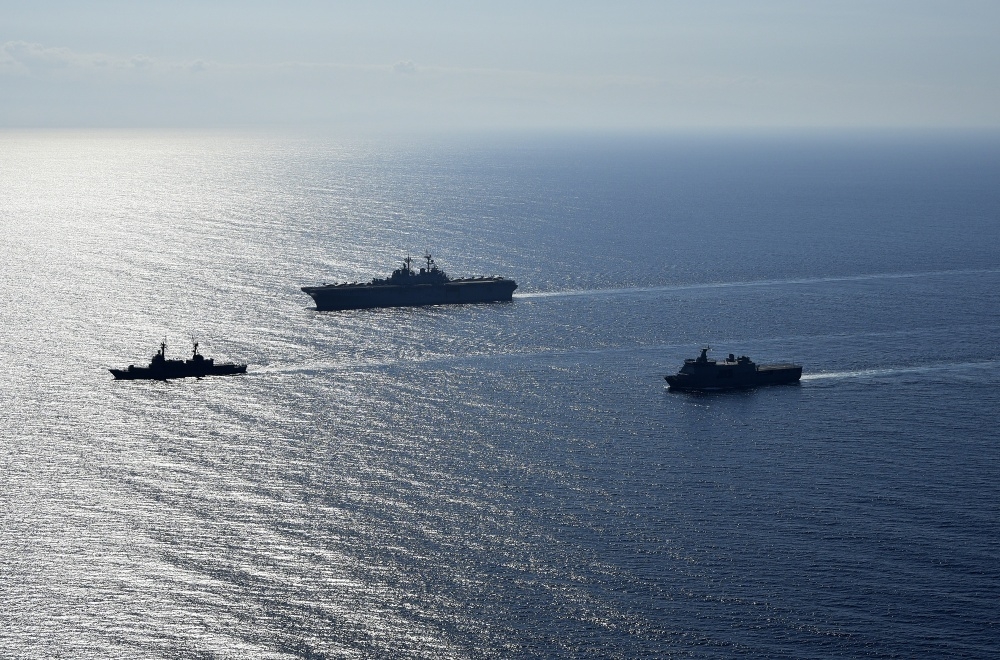by Debalina Ghoshal
A long-standing territorial dispute between Beijing and Manila over -- one of the Spratly Islands in the South China Sea, resurfaced in full force recently
- As protesters gathered outside the Chinese Embassy on April 10 in Manila, to express their outrage at China's naval aggression, U.S. and Filipino troops conducted a joint military exercise in the South China Sea, aimed at preparing the Philippines to "deal with any potential island invasion."
- Any such shift on the part of Manila towards Moscow should cause Washington to step up its engagement with the Philippines, to prevent Chinese and Russian attempts at controlling the South China Sea's rich resources and China possibly seizing it as a maritime chokepoint.

Increased
Chinese encroachment on the Spratly Islands should be cause for alarm
in Washington. This month, U.S. and Filipino troops conducted a joint
military exercise in the South China Sea, partly aimed at preparing the
Philippines to "deal with any potential island invasion." Pictured: The
US Navy amphibious assault ship USS Wasp (top center) maneuvers
alongside the Philippine Navy offshore patrol vessel BRP Ramon Alcaraz
and landing platform dock BRP Tarlac in support of Exercise Balikatan,
on April 5, 2019. (U.S. Navy photo by Mass Communication Specialist 1st
Class Daniel Barker)
|
A long-standing territorial dispute between Beijing and Manila over Thitu Island (also known as Pagasa), one of the Spratly Islands in the South China Sea, resurfaced in full force recently, when more than 200 Chinese boats were spotted in the vicinity of the island. Thitu Island is controlled and administered by the Philippines, and Filipino civilians and military personnel inhabit the island. Sovereignty over the island is claimed by the Philippines, China, Taiwan and Vietnam.
Increased Chinese encroachment on the Spratly Islands -- and a recent "goodwill visit" of Russian Navy ships to the Philippines -- should be cause for alarm in Washington.
In recent years, Beijing-Manila relations improved to the point where Philippines President Rodrigo Duterte and Chinese President Xi Jinping signed 29 cooperation agreements, including a memorandum of understanding on joint oil and gas development in the South China Sea.
In response to criticism in the Philippines over what was viewed as Duterte's dangerous appeasement of Beijing -- which historically has failed to respect Manila's claimed maritime borders or its claimed rights to the South China Sea's valuable resources -- Duterte justified his position on the grounds that "China is [in the South China Sea]... that is the reality, and America and everybody should realize that they are there."
The sighting of the Chinese vessels near Thitu, however, concerned even Duterte, who told Beijing to "lay off" the island, yet stopped short of threatening military action.
This is where the United States and Russia come into play.
As protesters gathered outside the Chinese Embassy on April 10 in Manila, to express their outrage at China's naval aggression, U.S. and Filipino troops conducted a joint military exercise in the South China Sea, partly aimed at preparing the Philippines to "deal with any potential island invasion." According to Channel News Asia:
"If they [Filipinos] were to have any small islands taken over by a foreign military, this is definitely a dress rehearsal that can be used in the future," Major Christopher Bolz, a US Army Special Forces Company Commander who took part in planning for the exercises, told CNA.Two days earlier, two Russian destroyers and a tanker -- classified by the Russian Navy as "large, anti-submarine ships" -- docked in the Philippines; it was the second Russian Navy visit to the Philippines this year. The first visit was in January, the same month that Philippines Defense Secretary Delfin Lorenzana announced that Manila should "revisit" its Mutual Defense Treaty with the U.S.
Lorenzana said that a review of the Mutual Defense Treaty was necessary: under its current terms, the U.S. "will only come to our aid when the metropolitan Philippines is attacked."
It should be noted that Lorenzana's concern was expressed at least five months before the recent arrival of U.S. troops in the South China Sea to train with the Philippines military for a "potential island invasion." Nevertheless, his statements were one indication that Manila was further distancing itself from Washington, and more likely with a view to Moscow as a backup, particularly as Russia has increased its influence in the region."He [Lorenzana] disclosed that one of the areas he wanted clarified was what would trigger mutual responses of aid. For instance, he asked whether the Philippines had to get involved if a shooting war broke out between China and the US 'somewhere there in Mischief Reef.'"
Any such shift on the part of Manila towards Moscow should cause Washington to step up its engagement with the Philippines, to prevent Chinese and Russian attempts at controlling the South China Sea's rich resources and China possibly seizing it as a maritime chokepoint.
Debalina Ghoshal is an India-based non-resident fellow at the Council on International Policy in Canada.
Source: https://www.gatestoneinstitute.org/14068/china-aggression-south-china-sea
Follow Middle East and Terrorism on Twitter
No comments:
Post a Comment